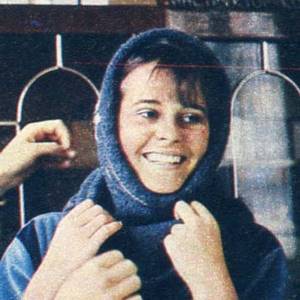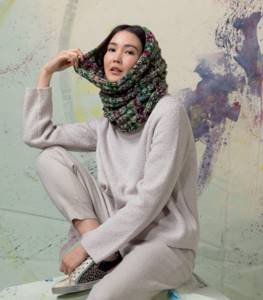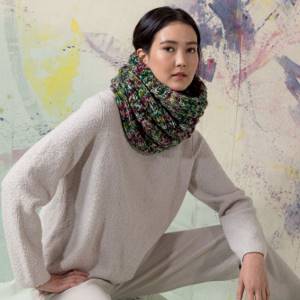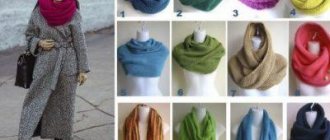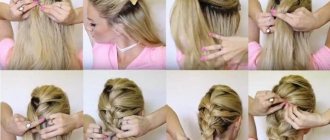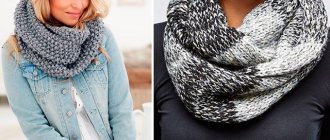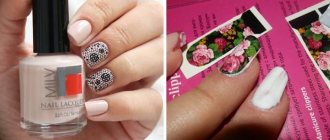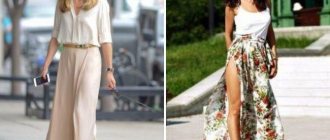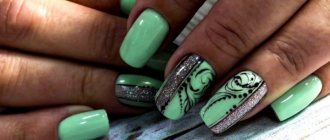- What is a snood and how to wear it - the history of the trend
- Analysis of models and names: snood scarf, collar, pipe, hood
- Video on how to knit a snood scarf for beginners with knitting needles
- Models made from thick and thin yarn - photo
- Knitting patterns for snood with description - new items 2019-2020 Knitted snood with aran pattern from Interweave Knits Holiday magazine
- Tall snood made of thick yarn with braids (detailed description)
- Air snood knitted in an openwork pattern
- Simple snood knitted in a voluminous waffle pattern
- Delicate mohair snood with openwork pattern
- Openwork snood knitted with Leaves pattern
- Snood pipe knitted using jacquard technique
Today snood is a fashionable autumn-winter accessory, adored by many due to its practicality. Scarf-pipe, scarf-collar - alternative names based on its versatility. A snood can serve as both a scarf and a hood, or rather a headdress that turns into a scarf. But few people can imagine that the original meaning of the concept “snood” had a different meaning.
What is a snood and how to wear it - the history of the trend
The concept "Snood" in translation means mesh. And this is understandable, the fact is that in the early 40s, at the peak of the outbreak of the war, girls wore nets on their heads, which served as a hair accessory. With their help, the hair was collected as if in a bag, did not get in the way while working, and the hairstyle looked aesthetically pleasing.
The ancestors of modern snoods appeared later. Around 1980, the funnel hat became a popular accessory. The older generation will certainly be able to confirm the fashion for headwear, which served as a hat, scarf or even a headscarf.
|
Snood in the modern sense appeared not so long ago. An explosion of popularity occurred in 2009, when fashionable Burberry and Missoni presented their new collections at Milan Fashion Week. The snood was a convenient, universal accessory, appropriate for both business and casual style. Fragile girls wearing jackets and flowing dresses, their shoulders shrouded in voluminous snoods, appeared on the catwalk. Men were also not deprived of attention to the newly introduced accessory. Snoods complemented the everyday images of brutal business men. Let's remember how it was.
Burberry Fall 2009 Collection
Missoni Fall 2009 Collection
Examples of how to wear a snood scarf with a jacket
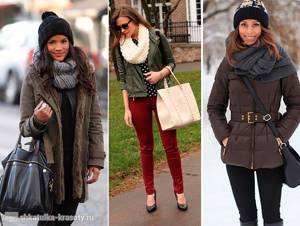
Knitted snood with jacket
The jacket is not a pretentious thing. This does not mean that a woman looks worse in a jacket than in any other outerwear. On the contrary, it is this item of clothing that gives more freedom to the actions and most vivid fantasies of its owner. With a jacket you can wear snood scarves of various bright colors, fancy styles with interesting decorative additions.
How to wear a snood with a jacket
With baggy and voluminous down jackets, accessories knitted with large knitting look incomparable. And in cold winter, bright colors will create the impression of warm sunshine, which gives joy to those around you.
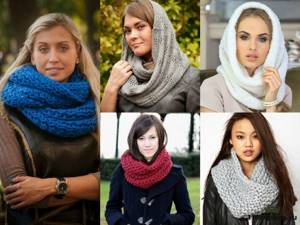
Options for wearing a snood with a jacket
Analysis of models and names: snood scarf, collar, pipe, hood
Knitted snood has been fashionable for more than 10 years and, perhaps, the most popular accessory during the cold season. During this time, the trend was both voluminous models knitted on large knitting needles and small accessories. Due to such modifications with volumes, the name also changed, but the essence remained the same.
A snood scarf is a long scarf, the ends of which are connected into a ring. When the concept of snood was just gaining popularity, an old long scarf instantly turned into a stylish accessory. Well, then, fashionistas began to knit unusually beautiful snood scarves from braids and arans for the winter, and for the summer, patterns made from openwork leaves and rhombuses remain popular.
Warm snood knitted with a relief pattern
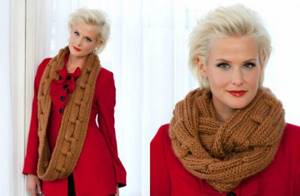
Scarf dimensions: circumference approximately 91.5 cm.
Knitting materials: 4 skeins (85 g each, i.e. 340 g in total) of Sheep (ish) Vickie Howell yarn (composition - 70% acrylic, 30% wool; 153 m per 85 g) camel color (Camel, no. 00010), 8 mm knitting needles, thick (darning or tapestry) needle, 2 small loop holders or 2 extra. knitting needles Knitting density (for stockinette stitch knitted with double thread): 12 stitches. and 14 rows - 10 by 10 cm.
Detailed description of the snood scarf with a relief pattern
Openwork snood knitted
Description of knitting an openwork snood
A knitted cowl scarf is a long, wide scarf. The peculiarity of its form is due to its functionality. The scarf collar functions not just as a neck accessory, but imitates a hood. In warm weather, it warms your shoulders, and when a strong wind blows, you can easily throw it over your head.
When knitting a collar scarf, take into account its dimensions. In order for the scarf to fit well on your shoulders and fit comfortably on your head, its length should be approximately 60 cm and width - 30 cm. It is better to choose dense knitting patterns so that the accessory does not allow cold air to pass through.
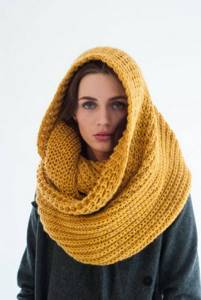
Trumpet is another type of snood. The tube scarf, as the name implies, has the shape of a looped fabric stretched upward. Its length is usually slightly larger than the volume of the head, but the height should be such that it is enough for the head and shoulders.
Below is an example of a knitted snood-tube on straight knitting needles in rotating rows.
|
|
As another example, we invite you to get acquainted with the work of the girls we found on Etsy. Here the snood is knitted on circular knitting needles.
Do you want comfort in bad weather? Choosing a snood
Autumn. It’s getting colder every day, and winter is just around the corner, so we warm ourselves up and dress in knitted clothes. We make sure to do it beautifully. Accessories are an integral part of a beautiful fashionable wardrobe. Namely, snood. An incredibly elegant and practical thing that gives comfort and warmth even in the most severe frosts.
This is perhaps one of the most fashionable and versatile accessories of this year. However, ladies who do not chase trends, but emphasize their taste with truly stylish things, will not be disappointed, because the variety of models and decor options is simply amazing. This piece of clothing can be elegant and relaxed at the same time.
The texture is very different: English voluminous elastic, large knitting, various braids, plaits, Aran weaving, colored ornaments, knitted or embroidered patterns in the form of graphic elements, ovals, circles and Scottish checks, abstraction and, loved by many, gradient - a smooth transition from one colors to another. A special delicacy will be the decoration with buttons sewn with fringed ribbons, voluminous woolen embroidery and knitted in large braids.
Voluminous snoods fit perfectly into classic elegant style, and into casual, casual chic, romantic, sporty, pop art and so on.
A voluminous snood cape is a cozy companion in winter: you can throw it over your head, wrap your neck and shoulders.
A snood made of wool with braids is not just a warm accessory: with its various original patterns, it stands out as a bright stylish detail.
A long, wide snood can be wrapped in a figure eight around the neck, or can be effectively draped over the head and shoulders.
A snood in the shape of a figure eight most effectively emphasizes the elegance and sophistication of a woman’s neck.
A snood on your head is very feminine. A snood pipe is a modern version of a hood. In addition, it emphasizes awareness of fashion trends. It warms and does not press your hair.
Now the color scheme: the favorite, of course, is classic gray and all its shades. As well as a combination of powdery and ash shades, mint and lemon tones, various floral and graphic patterns.
Discreet items will be perfectly complemented by a model in one of the fashionable shades - rich cherry, wine, all shades of dark chocolate, orange, lilac, purple and eggplant. For lovers of aristocracy, you should pay attention to snow-white, nude, pearl and asphalt colors.
It is worth remembering that a snood made of expensive materials in an aristocratic color palette should be worn exclusively with classic dark business coats made of expensive wool, cashmere or boucle.
When choosing a snood, it is important to consider not just the design and current colors, but also the materials from which this accessory is created.
For the greatest comfort, in the cold season, it is best to choose models made from natural yarn: natural sheep wool, merino, alpaca, angora, mohair. For elegant and truly sophisticated looks, use cashmere, as well as a mixture of wool and silk. Snoods made from natural materials will be wonderful companions in both severe frost and mild weather.
Please note - synthetics are no longer in trend, hypoallergenic - perhaps, but generally do not warm well, cause a feeling of discomfort, stretch, pill, and look cheap.
Analyzing all of the above, we are convinced that today a snood is no longer just a wardrobe item designed to provide additional protection during the cold season, it is a stylish accessory that adds chic and charisma to your image, making your look harmonious and complete. This is a good alternative to classic scarves if you want to feel relaxed and cozy and one of the most favorite items of your winter wardrobe. Elegant and uncomplicated with great potential when choosing an ensemble.
Be beautiful in any weather! Spectacular images for you!
Video on how to knit a snood scarf, diagram and description for beginners with knitting needles
- To knit a snood with knitting needles, it is important for beginners to know a few rules: 1. You must accurately determine the size of the finished product. To do this, measure the circumference of your head. As a rule, in an adult the value varies from 52 to 64 centimeters. For a one-turn snood, add 2-3 centimeters to the circumference, while the width is usually about 30 cm. If you want a two-turn snood, then the recommended length is 140 cm and the width is about 22-25 cm.
- The size of the knitting needles must exactly match the thickness of the yarn. Recommended needles are usually listed on the yarn packaging.
- Choose a pattern for your future snood. If you want the result to be warm and cozy, opt for semi-patent patterns such as ribbing or any other dense patterns.
- Before you begin, be sure to knit the sample, wash it and dry it. And only then start making calculations. Calculations are very important! So don't skip this step.
- Once the sample is connected and calculations have been carried out. Get to work.
- Wash and dry the finished product on a flat surface. After complete drying, perform a damp heat treatment with an iron!
We found a detailed video about knitting a snood in two turns on the KNITTING SECRETS channel from Irina Akman.
Svetlana Kolomiets on her channel also shares lessons on how to knit a snood on large knitting needles.
How to wear a snood
A scarf collar can be tied in dozens of ways. Try one of these options.
One turn
Photo: Aksana Lebedz / Shutterstock
The most obvious way to wear not very long snoods: just put your head through it and straighten it across your chest. The vertical that the accessory creates will visually elongate the silhouette.
A snood worn this way will look best with classic coats and trench coats with V-necks. To make the look more interesting and at the same time wrap your neck better, grab the scarf with a brooch.
Like the hood
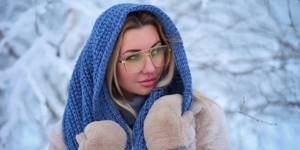
Another very simple option. Put on the snood in the same way as in the first method, but do not lower the top edge behind the neck, but cover your head with it. If the scarf is wide, tuck it around the perimeter. You can wear such a snood hood instead of a hat and not be afraid that it will ruin your hairstyle.
In two turns

To put on the snood in two turns, stick your head into it. Pull the hanging part in front of you and roll it into a figure eight. Place the bottom loop around your neck and straighten the scarf. You can give the loops equal length. But if you want to lighten the neck and shoulder area and appear a little taller, pull one of the elements forward.
This method is especially good for combining a snood with a down jacket. Wear a scarf under a loose-necked jacket. If it is narrow, tie a snood over the hood. In this case, if possible, remove the fur trim from the latter so as not to overload the portrait area.
Like a hood
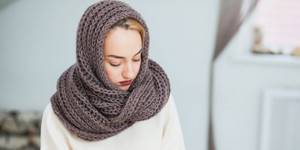
This method is similar to the previous one, but it helps to more reliably protect your head from the wind. Roll the snood into a figure eight. Thread your head through one loop and cover the top with the other like a hood. So the accessory will replace both your scarf and hat. Non-voluminous knitted wool snoods look best in the form of a hood.
On the chest over outerwear
This method will make the look fresh and stylish. Wear the snood as an award ribbon: one part will cover the shoulder, and the other (depending on the length) will be at the hip or waist, forming a diagonal.
Use eye-catching scarves in fur, print or color block to transform and insulate minimalistic raincoats and coats in soothing shades.
View this post on Instagram
Posted by SeldaG (@edislda)
If the accessory is voluminous, tie it with a thin belt on top to emphasize the waist. You can also wear regular long scarves and silk scarves in a similar way by simply tying their ends.
On shoulders
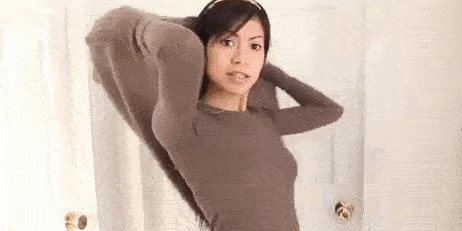
A long knitted or knitted snood can be turned into something like a shawl or cape. To do this, place your hands behind your back and thread them into the scarf. Straighten the snood over your shoulders. This cape is best worn with sweaters and jumpers of similar shades.
Like a vest
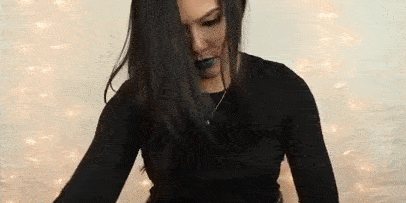
The scarf can easily be turned into a vest. To do this, insert your head into the snood and lower it to waist level. Pull the free part of the scarf forward and cross the fabrics. Throw the resulting loop behind your neck and straighten the scarf over your chest.
Try wearing textured knit snoods like this. They pair well with basic long sleeve shirts and turtlenecks. If the scarf is wide enough, you can even wear it on your naked body as a top.
Like a turban

Style your hair in a high bun. Place your head in the scarf and pull it well at the back to gather your hair. Wrap the snood tightly around your head several times, carefully crossing it at the forehead and back of the head. Carefully tuck or tie the rest into a knot, and hide the protruding parts. In this original way, it is better to wear thin and bright cotton snoods.
Models made from thick and thin yarn - photo
The choice of yarn for each product is a very important point. To knit light, flowing fabrics, you should choose thin threads such as down or mohair. If you need to get a dense fabric, then pay attention to merino or mixed threads.
Let's see what snoods made from different types of yarn look like.
Some time ago it was very popular to knit items from very thick yarn not with knitting needles, but by hand. A bit of a strange trend, but still, many still consider this method of creating products. This is what a snood looks like tied in this way.
And here is an example of a knitted snood on large knitting needles made of soft yarn, which contains mohair and acrylic. Example taken from yarn website https://www.katia.com/. It is worth noting that such models gracefully emphasize fragile shoulders and do not look rough. This snood is convenient to wear over outerwear and conveniently tucked under a jacket or coat.
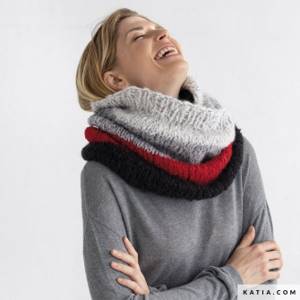
Large merino or wool threads do not provide such plasticity. But this is not a reason not to use such yarn for knitting. The merino snood is warm and comfortable, despite its volume. It perfectly serves as a scarf tied over outerwear.
Openwork snoods are more like jewelry. They serve more of a decorative role and therefore look elegant. This accessory will complement an elegant suit or dress. If you want to knit an openwork snood, a diagram of one of the options is presented below.
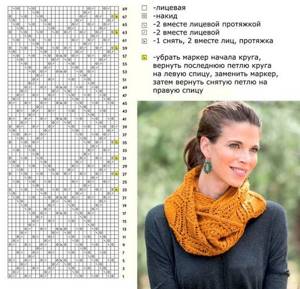
LiveInternetLiveInternet
Recently, the scarf-collar, which is also called a scarf-loop, snood or scarf-tube, has regained its former popularity. Initially, the scarf-collar played the role of a woman’s headdress, resembling a hood in appearance, but in the mid-sixties it began to be increasingly worn as a scarf. Snood looks stylish, but still not every girl decides to buy it, since many do not know what and how to wear a scarf collar.
A tube scarf, unlike ordinary scarves, is a closed ring, not a strip. Snood can be made from fur, boucle, knitwear; knitted scarf-collars that look like a sweater collar are also very popular. In fact, this product is something between a scarf, a hood and a hat; it can simultaneously perform the functions of a scarf and a headdress.
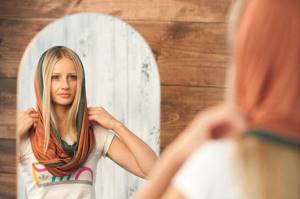
There are also snoods made from lightweight fabrics that help complement your summer look. We’ll talk about them in this post... So, in the warm season, warm scarves-collars are replaced with thin, weightless snoods, the light loops of which form an exquisite drapery, which can be strengthened with the help of large earrings. You can also use a snood in the fall when it suddenly gets a little colder, throwing it over a light blouse, and in the evening adding a windbreaker to it.
There are many ways to wear a cowl scarf. The simplest and most common is to simply wear it around your neck like beads. In this version, a long, light snood looks great with a cardigan or jacket, and an openwork collar looks great with a dress.
Place the scarf around your neck without wrapping or tying it. This method is laconic and simple, and the scarf will thus emphasize and visually lengthen the neck and silhouette.
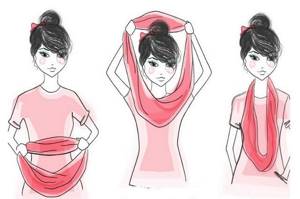
You can wear a scarf-collar as a headdress:
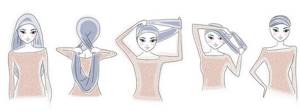
If you want to wear one snood at the same time as a scarf and a headdress, try the following: throw the scarf around your neck, twist it, put the top loop over your head like a hood, and straighten the bottom loop around your neck. This bow is suitable for cold weather, replacing a hat.
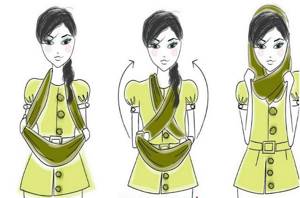
If you want to give your cowl scarf more volume, twist it so that it resembles a figure eight and place the resulting loops around your neck. This option complements outerwear well. If the scarf is very long, you can wrap it around your neck several times and then experiment with the placement of the loops. You can complement the look by pinning an exquisite brooch to the scarf.
Place the scarf-collar around your neck, twist it and put it back on your neck, only this time leaving one loop longer. This is another very simple way to diversify your usual look and visually lengthen your silhouette.
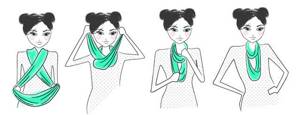
The snood can also be used as a cape-cape. To do this, you just need to pull it over your shoulders, which will help give the look a layered look. A similar technique works great with outerwear. However, keep in mind that the warmer the clothing you are wearing the loop scarf with, the larger the knitting should be.
Two simple ways to wear a snood scarf in everyday life as a neck decoration: Throw the collar around your neck, twist it and put the additional loop back on your neck. This method is considered the classic and most common.
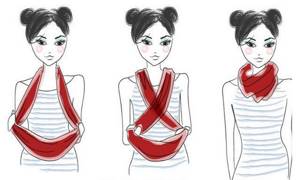
Fold the scarf in half, wrap it around your neck and thread one end through a loop on the other. This method looks more formal than the double loop and is borrowed from the classic scarf.
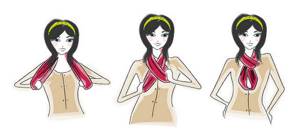
The snood, worn as a bolero, looks quite original. The scarf should be straightened behind your back, your hands should be threaded through it and the fabric should be lifted up, pulling it over your shoulders. If the scarf is sagging because it is very long, you can first thread one hand through, make a cross on the back, and then thread the other hand through.
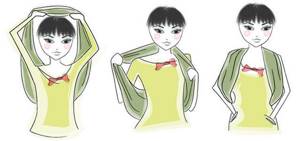
Impromptu bolero in addition to the usual office shirt: Throw a scarf-collar over one shoulder, and then, making a loop, put it on the other. This feminine look will add sophistication to your look, especially if your scarf is a large knit. Please note that this look is suitable for a fitted top, jumper or long-sleeved dress, but is completely contraindicated for a jacket or jacket.
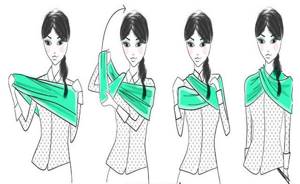
In addition, a long loop scarf can be worn as a vest. To do this, you need to put it on your waist, cross it in front or behind, and put the resulting loop around your neck. This way you will emphasize the shoulder line and create a feminine look. Then the snood fabric can be straightened over the shoulders, but this is not necessary.
And, of course, it’s worth seeing how to wear a snood scarf in the form of a skirt, an elegant beach dress or a pareo:
If you want to give your look a slightly casual and asymmetrical look, wear it on just one shoulder without crossing the scarf.
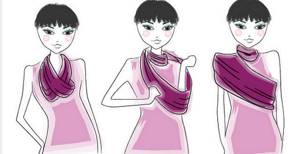
Source
The main advantage of a snood over a regular scarf is its simplicity: there is no need to come up with tricky knots or master different ways of tying a scarf.
Use the tips presented in the videos. The effect is simply amazing!
See also:
How to beautifully tie scarves, scarves, pareos
10 ways to tie a scarf
25 ways to tie a neckerchief
Knitting patterns for snood with description - new items 2019-2020
Knitted snood with aran pattern from Interweave Knits Holiday magazine
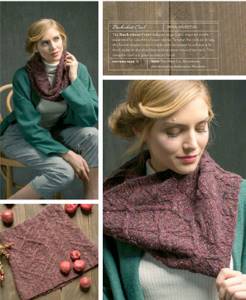
The snood, the diagram and description of which you will find below, is made of tweed yarn. The tweed blend thread is unique in its texture and color; the fabric has an interspersed effect. The result is a unique and very warm product.
Dimensions: bottom edge circumference – 75 cm, top edge circumference – 61 cm.
You will need: The Fiber Co. Yarn. Arranmore (80% wool, 10% cashmere, 10% silk; 160 m / 100 g) – 2 skeins. Circular knitting needles No. 5 and No. 5.5, 40 cm long, markers, two auxiliary knitting needles.
Knitting density: 18 loops and 22 rows = 10 cm pattern with strands.
Attention. The scarf is made in circular rows, from bottom to top.
Description of knitting a snood with knitting needles
Using size 5 needles, cast on 132 sts. Place a marker and join the stitches in a circle. Perform 1-8 rounds. rows of pattern according to the diagram. Change knitting needles to number 5.5.
Complete 9-62 r. pattern - there are 108 loops on the knitting needles. Change knitting needles to number 5. Knit rows 63-69 of the pattern. Close all loops. Finally, thread the ends of the threads. Steam the snood scarf.
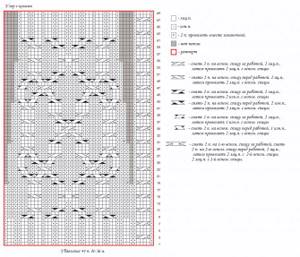
Source: Interweave Knits Holiday Magazine
Tall snood made of thick yarn with braids (detailed description)
Sizes: S/M (L/XL) Shoulder width: 100 (110) cm Product length: 38 (38) cm
You will need: Yarn (96% alpaca wool, 4% nylon; 50 g/110 m) – 3 (3) skeins of gray melange; circular knitting needles No. 7, length 40 and 60 cm; auxiliary needle for “braids” No. 7; 1 stitch marker.
Knit stitch: Always knit stitches in rounds. Knitting density: 14 p. x 19 p. = 10 x 10 cm, knitted on circular needles No. 7. How to do the work: Using double thread on circular needles No. 7, cast on 144 (156) sts. Important: do not pull the thread. Cut one thread. Knit 5 r. facial in forward and reverse direction. Continue knitting in the round alternately with stockinette stitch and a braid pattern: purl 1, * knit 8. (= “braid”), purl 1, knit 5 (7), purl 1, knit 8. (= “braid”), purl 1*, repeat from * to * 6 times, not counting the last purl loop. Attach 1 marker on both sides of the work: to the 1st purl. loop of the row and to the purl loop after the 6th “braid”. 3 r. knit directly according to the pattern and in the next row cross the loops in the “braids”: All odd “braids”: leave 4 sts on the auxiliary knitting needle before work, knit the next 4 sts, then knit the loops from the auxiliary knitting needle. All even “braids”: leave 4 stitches on the auxiliary needle while working, knit the next 4 stitches, then knit the loops from the auxiliary needle. Repeat these “braids” every 6th row. until the end of work. At the same time, in areas of the facial surface between the “braids” in 10 (12) r. after persons Decrease rows: P1, * k8, p1, knit 2 sts together, knit 1 (3), slip 1 p, k1, then pull it through the removed loop, purl 1. , k8, purl 1*, repeat from * to * 6 times, not counting the last purl stitch. Make the following decreases in the 16th (18th) row: P1, * K8, P1, slip 1 stitch, knit 2 stitches together and pull through the removed loop (knit 2 stitches together, K1, slip 1, k1, then pull it through the slipped loop), p1, k8, p1*, repeat from * to * 6 times, not counting the last purl loop. Make the following decreases in 20 (22nd) rows: purl 1, * knit 8, remove 1 st as purlwise, purl 2 stitches together and pull through the removed loop (purl 1, remove 1 st , knit 2 stitches together and pull through the removed loop, purl 1), knit 8, purl 1*, repeat from * to * 6 times, not counting the last purl loop. For size S/M: knit straight, performing only 11 crossings for “braids” + 4 rows. For size L/XL: make the following decreases in the 24th row: 1 p., * 8 knits, 1 p. slip as purl, 2 p. knit together purl and pull through the removed loop, 8 knits, 1 p. *, repeat from * to * 6 times, not counting the last purl stitch. Knit straight, making only 11 crossings for “braids” + 4 rows. Next knit 5 r. facial in forward and reverse direction. Close the loops with double thread on the wrong side of the work.
Assembly: Fasten the ends of the threads. Steam the product carefully.
Photo: Burda Creazion magazine No. 1/2019
Air snood knitted in an openwork pattern
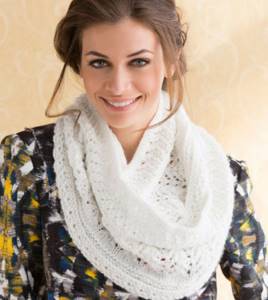
Size: 147.5*25.5 cm. Materials: 2 skeins of RED HEART Sparkle Soft yarn (99% acrylic, 1% metallic, 113 g/190 m), circular knitting needles 5.0 mm. length 60 cm. Knitting density: 16 loops * 21 rows = 10 * 10 cm.
Snood description: Using circular knitting needles, cast on 231 stitches. Place a mark and connect in a circular row. Check that the hinges are not twisted. Knit in the round according to the pattern.
Shawl pattern: 1st row: purl. loops 2nd row: knits. loops 3rd row: purl. loops
Openwork pattern: 1st row: * 1 knit, yarn over, 2 knits together, repeat from * 2nd row: knit. loops. Rows 3-6: repeat rows 1 and 2. Row 7: *K1, slip as knit, k1. Throw the removed loop over the knitted one, yarn over, repeat from * 8th row: knit. loops. Rows 9 and 10: repeat rows 7 and 8. 11th row: repeat 7th row
Shawl pattern 2: Row 1: knit. loops. 2nd row: purl. loops. Rows 3 and 4: repeat rows 1 and 2. 5th row: faces. loops.
Central pattern : 1st and 2nd rows: faces. loops. 3rd row: *k1, k2tog, yo, k1, yo, slip as knit, k1. Throw the removed loop over the knitted one, k1, repeat from * 4th row: knit. loops. 5th row: *K2tog, yo, k3, yo, slip stitch as knit, k1. throw the removed loop over the knitted one, repeat from * 6-21 rows: repeat rows 1 and 5 – 4 times. Rows 22 and 23: faces. loops.
Simple snood knitted in a voluminous waffle pattern
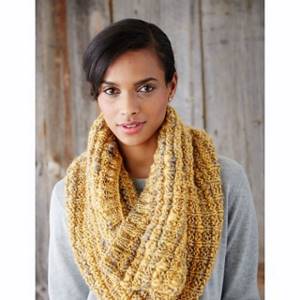
Size : 48 cm in height and 81.5 cm in circumference
You will need: Patons® Uplands™ yarn (50% wool, 50% acrylic, 90 g/90 m) 4 skeins, circular knitting needles 6.5 mm, length 60 cm
Knitting density: 8 loops and 16 rows = 10x10 cm in the main pattern
Description of knitted snood for women
Cast on 112 stitches, place a marker, join the stitches in a circle.
Rounds 1-5: *k2, p2, repeat from * around.
Round 6: knit, evenly increase 2 sts.
Round 7: knit.
Rounds 8 and 9: *P2, k1, repeat from * around.
10th and 11th circles: knit.
Repeat last 4 rows to a height of 45.5 cm from the cast-on edge, finish in the 9th circle and evenly decrease 2 stitches in the last. circle. Knit 5 circles with a 2x2 elastic band, bind off the loops according to the pattern.
Knitting snood pattern, diagram and video
Choosing a pattern for a snood is not too difficult. It is enough to imagine the final version of the product or look at similar knitted models. But it’s not always easy to calculate rapport correctly; after all, not all patterns are suitable for knitting a snood. You must understand that a snood is mostly a pipe. Therefore, the pattern should not contain a large number of yarn overs and unnecessary expansion or contraction.
To avoid such complications, many people choose simple patterns, such as a regular 2x2 rib or English rib. But don’t force yourself into rigid limits; there are many patterns that will help you create a unique accessory.
Snood knitted with Wave pattern
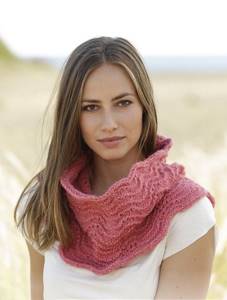
Tube scarf knitted with braid pattern
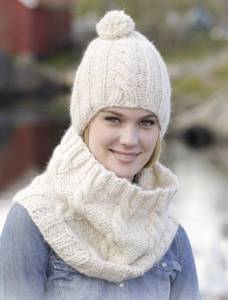
Openwork snood knitted with a herringbone pattern
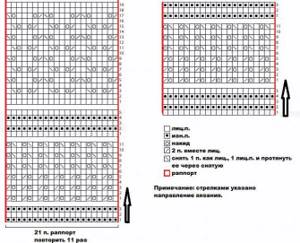
Openwork snood with a pattern of small leaves
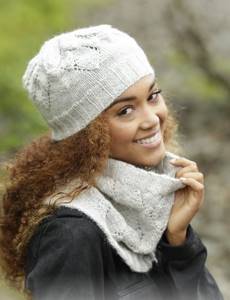
What to combine snood with in winter
Fashionistas can rest assured about their appearance if they decide to use a snood as a stylish accessory. It can be worn with a down jacket of any silhouette, not only as a scarf, but also as a hood. You can throw it over your head outdoors and use it indoors as a voluminous collar. Some women consider the combination of a down jacket with a hood and the product discussed in this review unacceptable. Although, if you wish, you can unfasten the hood, but if this is not possible, then it is quite easy to miss this type of scarf under it. In this case, it is better to give preference to voluminous knitted models. Winter snoods go well with both casual formal items and sportswear.
The combination of a winter coat and a fur snood looks especially luxurious. Important detail: the coat should have a small collar or no collar. The snood can be worn as a fur scarf or cape. It is not necessary to purchase an accessory to match the coat; you can opt for a bright fur product. But it’s better to choose a knitted, rather than fur, snood for a fur coat. Otherwise, the image will look too bulky.
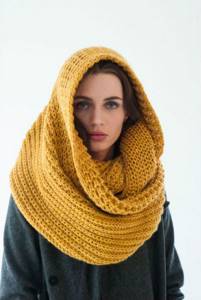
In winter, snood can be worn not only as an addition to outerwear. For example, in a cool room, a warm scarf will help keep you warm and will fit perfectly into the office style. It can be worn over a turtleneck, in which case it will look like a cowl collar. A long, voluminous scarf can be used as a cape. This accessory will look especially elegant if you decorate it with a brooch.
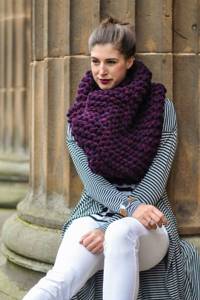
Additional selection of photos:
If you still doubt whether you should buy yourself a fashionable snood, cast aside all doubts, believe me, once you try on this thing, you will no longer want to part with it. See you again on the pages of the site “Kabluchok.ru”.
Openwork snood: diagrams, description, video
Delicate mohair snood in two turns
An original, very feminine snood model, made of airy mohair. The pattern seems complicated only when I see it, but in fact it is quite simple to knit. Like all similar patterns, the snood is knitted in the round. The volume of the openwork pattern is obtained through the use of thin yarn and thick knitting needles 4-5 mm.
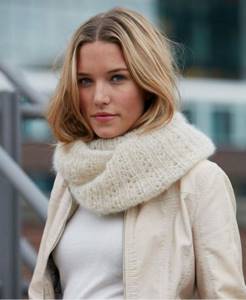
To knit such a snood you will need: Schachenmayr Kid Light yarn (38% nylon, 32% acrylic, 30% mohair, 100 g/600 m) 1 skein, circular knitting needles 80-100 cm long, 4-5 mm
As a result, the product will be 110 cm in circumference and 40 cm in height. Knitting density: 18 stitches and 24 rows = 10x10 cm in stockinette stitch.
How to knit an airy snood with knitting needles in an openwork pattern, diagram and description: Openwork pattern (number of loops in multiples of 6): 1 circle: *P1, k2, p1, yarn over, remove 1 p .as persons., 1 person.p. and stretch it through the removed one, repeat from * in a circle. Round 2: *P1, k2, repeat from * around. Round 3: *P1, k2, p1, k2tog, yarn over, repeat from * around. Round 4: knit as round 2. Repeat 1-4 circles.
Cast on 216 stitches, join into a circle, place a marker for the beginning of the circle. Knit with an openwork pattern to a height of 40 cm, finish in 1 or 3 circles of the pattern. Close the loops.
You can knit a bright openwork snood complete with a fashionable hat using MK Fashionable knitting PINOCCHIO.
Openwork snood with a pattern of superimposed leaves.
If you don’t like knitting from mohair and prefer a thicker fabric, then try knitting a snood, for example, from merino wool. The canvas will be smoother and the pattern clearer. Compared to a mohair snood, a wool product knits faster and is more unpretentious to wear.
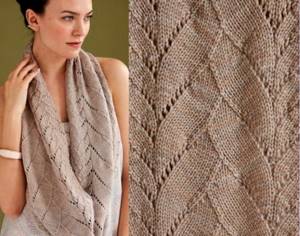
Snood is knitted with straight fabric in turning rows. Once you have knitted the length you need, the fabric closes into a ring. Knitting snood turns in rows is convenient if you are knitting a long product and plan to wear it in several turns.
Women's two-turn snood
A snood of two or more turns creates volume, which means it better warms the neck and back. But despite such an important feature, suitable for our climate, many do not like to knit such products. At the moment, turning rows have generally lost popularity, and this is how snoods are knitted in two or more turns.
In addition, long fabrics must be closed in a circle; an unsightly seam is formed. But there is one way that will help make the junction of the fabric almost invisible. Grafting is an invisible knitted stitch, loop to loop. Excellent for joining fabrics with open loops.
As an example of using grafting when knitting a snood, we suggest you pay attention to the model with openwork leaves.
Openwork snood knitted with Leaves pattern
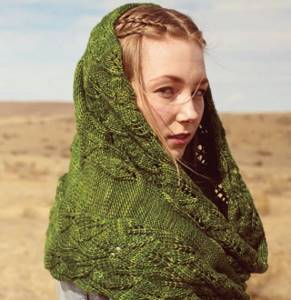
Openwork snood knitted with Leaves pattern
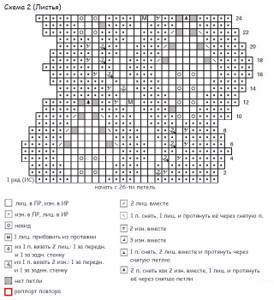
Snood size: circumference 100 cm, height 50 cm. For work you will need: 3 skeins of Madelinetosh Tosh Merino yarn (100% merino wool; 192 m/100 g); circular needles 5.5 mm 60 cm long, stitch markers, knitting needle.
Knitting density: 18 p. and 24 r. = 10x10 cm in stockinette stitch.
The snood is knitted with straight fabric, then the open loops are connected using the Grafting method.
Description of knitting snood
Pre-cast on using a hook with a thread of a contrasting color to cast on 104 sts. Leave a piece of working (main) thread of approximately 100 cm for grafting. Do not connect in a circle.
Track. R. (IS): knit 32 sts of the 1st row according to pattern 1 (Stem), place a marker (RM), then k7, PM, then knit 26 sts according to pattern 2 (Leaf), PM, then k7. , then 32 sts of the 1st row according to pattern 1 (Stem).
Track. R. (LS): knit next. row according to pattern 1 to the marker, re-shoot the marker (M), then purl 7, M, then next. row according to pattern 2, M, then purl 7, M, then next. R. according to scheme 1.
Knitted scarf collar photo Knitted scarf collar photo Continue as established according to the Stem and Leaves patterns. Complete 1-24 r. according to the Leaves pattern 10 times, finish with the 16th row of the pattern according to the Stem pattern = approximately 100 cm from the start of work. Do not close the loops. Cut the thread.
Connecting loops.
Remove the auxiliary thread from the temporary cast-on row and transfer 104 sts to circular knitting needles, then pick up an additional loop at the beginning of the row with the thread of the left segment = 105 sts. Thread the piece of thread into a knitting needle. Holding the needles parallel (needle with 105 stitches behind), connect the stitches from both needles as follows: [2 sts. stitch, 13 stitches with stockinette stitch] 2 times, then 18 stitches with purl stitch, 3 stitches with stockinette stitch, 4 stitches with purl stitch, 5 stitches with stockinette stitch, 14 stitches with purl stitch, [13 stitches with stockinette stitch, 2 p. purl stitch] 2 times.
Intarsia and jacquard - snoods made of yarn of different colors
Snoods made using the jacquard technique are denser and warmer. They look more interesting and generally refresh any look. It is worth noting that a colored accessory creates an accent, so when planning your wardrobe, you need to take this feature into account.
Most often, snoods using the jacquard technique are knitted in a circle, marking the beginning of the row with a marker. Products with two turns are much less common. Jacquard has a not very beautiful reverse side. If such a fabric is twisted (as is the case with several turns), then the wrong side will be visible. This effect doesn't look very neat. But if you have set a goal for yourself and have a great desire to have a jacquard snood, then you can try to knit it double, or make an interesting plain lining.
Snood pipe knitted using jacquard technique
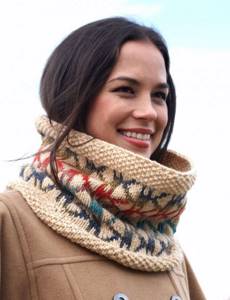
Dimensions : height: 24 cm, circumference: 71 cm
You will need: Bernat® Super Value™ yarn (100% acrylic, 197 g/389 m) 1 skein beige, Bernat® Mosaic™ (100% acrylic, 100 g/191 m) 1 skein, circular needles 4.5 mm and 5.5 mm length 40 cm
Knitting density: 16 loops and 20 rows = 10x10 cm in stockinette stitch on 5.5 mm needles with OC thread
Description of the snood with knitting needles Note: when knitting according to the color pattern, pull the thread along the wrong side, and the pull should not be more than 3 loops. If the broach turns out to be longer, cross both threads together and continue knitting.
On 4.5 mm needles, cast on 119 stitches using OC thread, join into a circle and place a marker.
** Round 1: *k1, p1, repeat from * around, finish with k1.
Round 2: *P1, k1, repeat from * around, finish with P1. Repeat circles 1 and 2 - pearl pattern with knitting needles - 3 more times.**
Track. circle: *17 knit stitches, 1 stitch from broach, repeat from * around = 126 loops.
Switch to 5.5 mm knitting needles and continue knitting according to the color pattern, repeating the horizontal repeat of the pattern of 9 loops 14 times. Repeat rows 1-10 3 more times, then rows 1-4 1 more time. Cut thread A.
Track. round: knit with OC thread *16 knit stitches, 2 knit stitches together, repeat from * in circle = 119 loops. Switch to smaller needles and knit ** to **. Close the loops.
Beautiful snood scarf in two turns with openwork
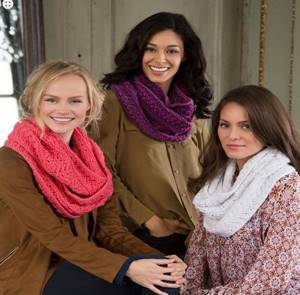
The second model is a beautiful women's snood with two turns, consisting of three sections of openwork, separated by two rows of a scarf pattern. Size: 15.5 by 150 cm. You will need: – medium density yarn – 250 grams; - knitting needles No. 6 on a long fishing line.
Pattern with openwork No. 1: 1 p.: * 1 knit, yarn over, 2 sts together knit.* – repeat from *; 2p.: knits.p.; 3-6 r.: repeat 1 and 2 r.; 7p.: * K1, k2 together, yarn over *; 8r.: like 2nd r.; 9-10: like 7-8 rubles; RUR 11: same as RUR 7
Openwork pattern No. 2: 1, 2, 4 p.: knits.p.; 3p.: * 1 knit, 2 together, yarn over, 1 knit, yo, 2 together, 1 knit. *; 5p.: * 2together, yarn over, 3 knit, yarn over, 2 together *; 6-17 rubles: repeat from 2nd to 5th – 3 rubles; 18-19 r.: knitsev.p.
Knit the fragments in garter stitch (knit 1, purl 2) according to the snood pattern in the number of rows indicated.
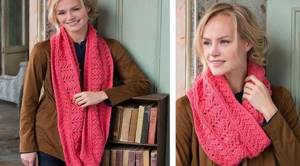
Description of knitting a snood: cast on 210 stitches. The repeat indicated in the diagram consists of 21 stitches. In total, for a snood you need to cast on 11 rapports, i.e. 210 p.
